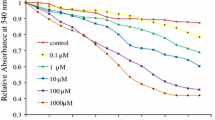Abstract
Twenty-two pesticides were examined in vitro for their effects on hepatocytes, mitochondria, and microsomes isolated from male rats. Twelve pesticides reduced non-protein sulfhydryl (NPSH) content in hepatocytes to less than 80% of control at a concentration of 10−3 M. Chlorothalonil and ziram were especially effective, reducing NPSH content at 10−4 M after 90 min incubation. Among those pesticides, only copper terephthalate and chlorothalonil were reactive with glutathione non-enzymatically and enzymatically, respectively. Lipid peroxidation in hepatocytes was stimulated by four pesticides, namely, chlorothalonil, pretilachlor, ethoprofos, and metribuzin at 10−3–10−4 M. Cell viability was considerably decreased following incubation with chlorothalonil, trichlamide, and ziram. Hepatotoxicity of trichlamide was considered to be associated with its direct adverse effects on mitochondrial energy production, since it uncoupled isolated mitochondrial respiration at 10−6 M and depleted cellular ATP content prior to cell death. Conversely, chlorothalonil- and ziram-induced hepatotoxicity seemed to be related to their depleting effects on cellular sulfhydryls, since addition of the thiol compound dithiothreitol to the hepatocytes incubation mixture protected cells. With respect to isolated mitochondrial respiration, four pesticides inhibited state 3 and/or state 4 respiration rates at 10−3–10−4 M, whereas seven pesticides uncoupled state 4 respiration at 10−3–10−6 M. With respect to isolated microsomal lipid peroxidation, three pesticides were peroxidative at 10−3–10−4 M, whereas three pesticides were antioxidative at 10−3–10−7 M. Only two pesticides, β-endosulfan and metalaxyl, had essentially no effects on any parameters tested at 10−3 M.
Similar content being viewed by others
References
Ansari RA, Siddiqui MKJ, Gupta PK (1984) Toxicity of endosulfan: Distribution of α- and β-isomers of racemic endosulfan following oral administration in rats. Toxicol Lett 21:29–33
Bonfanti M, Taverna P, Chiappetta L, Villa P, D'Incalci M, Bagnati R, Fanelli R (1992) DNA damage induced by alachlor after in vitro activation by rat hepatocytes. Toxicology 72:207–219
Buege JA, Aust SD (1978) Microsomal lipid peroxidation. In: Fleischer S, Packer L (eds) Methods in enzymology vol 52. Academic Press, NY, pp 302–310
Cinti DL, Moldeus P, Schenkman JB (1972) Kinetic parameters of drug-metabolizing enzymes in Ca2+-sedimented microsomes from rat liver. Biochem Pharmacol 21:3249–3256
Coasta LG, Murphy SG (1984) Interaction between acetaminophen and organophosphates in mice. Res Commun Chem Pathol Pharmacol 44:389–400
Dicowsky L, Morello A (1971) Glutathione-dependent degradation of 2,2 dichlorovinyl dimethyl phosphate (DDVP) by the rat. Life Sci 10:1031–1037
Dubey RK, Beg MU, Singh J (1984) Effects of endosulfan and its metabolites on rat liver mitochondrial respiration and enzyme activities in vitro. Biochem Pharmacol 33:3405–3410
Ellman GL (1959) Tissue sulfhydryl groups. Arch Biochem Biophys 82:70–77
Gallagher EP, Kedderis GL, DiGiulio RT (1991) Glutathione S-transferase mediated chlorothalonil metabolism in liver and gill subcellular fractions of channel catfish. Biochem Pharmacol 42:139–145
Gallagher EP, Canada AT, DiGiulio RT (1992) The protective role of glutathione in chlorothalonil-induced toxicity to channel catfish. Aquat Toxicol 23:155–168
Gupta PK, Chandra SV (1977) Toxicity of endosulfan after repeated oral administration to rats. Bull Environ Contam Toxicol 18:378–384
Hayes WJ, Laws ER (1991) Handbook of pesticide toxicology. Academic Press, NY
IARC (1983) Monographs on the evaluation of carcinogenic risks to humans, vol 30: Miscellaneous pesticides. International Agency for Research on Cancer, Lyon, France, pp 319–328
— (1991) Monographs on the evaluation of carcinogenic risks to humans, Vol 53: Occupational exposures in insecticide application, and some pesticides. International Agency for Research on Cancer, Lyon, France, pp 423–438
Johnson D, Henry L (1967) Isolation of liver and kidney mitochondria. In: Estabrook RW, Pullman ME (eds) Methods in enzymology vol 10. Academic Press, NY, pp 94–96
Nagamatsu K, Kido Y, Terao T, Ishida T, Toki S (1982) Protective effect of sulfhydryl compounds on acute toxicity of morphine. Life Sci 30:1121–1127
Scarabelli L, Giannoni P, Malfatto C, Bolognesi C, Ceasarone CF (1993) Relationship between poly(ADP-ribose) polymerase activity and DNA damage induced by zinc dithiocarbamates in mouse and rat liver. Mutation Res. 302:1–6
Seglen PO (1976) Preparation of isolated rat liver cell. In: Wilson L (ed) Methods in cell biology vol 13. Academic Press, NY, pp 29–83
Stevens JT, Summer DD (1991) Triazines and triazoles. In: Hayes WJ, Laws ER (eds) Handbook of pesticide toxicology. Academic Press, NY, pp 1380–1389
Sultatos LG, Woods L (1988) The role of glutathione in the detoxification of the insecticides methyl parathion and azinphos-methyl in the mouse. Toxicol Appl Pharmacol 96:168–174
Szarkowska L, Klingenberg M (1963) The role of ubiquinone in mitochondria. Biochem Z 338:674–697
Tomizawa C, Ueji M, Koshioka M (1989) Pesticide data book. Soft Science Publ, Tokyo.
Vincent PG, Sisler HD (1968) Mechanism of antifungal action of 2,4,5,6-tetrachloroisophtalonitrile. Physiol Plant 21:1249–1264
Yamano T, Morita S (1993) Effects of pesticides on isolated rat hepatocytes, mitochondria, and microsomes. Arch Environ Contam Toxicol 25:271–278
Author information
Authors and Affiliations
Rights and permissions
About this article
Cite this article
Yamano, T., Morita, S. Effects of pesticides on isolated rat hepatocytes, mitochondria, and microsomes II. Arch. Environ. Contam. Toxicol. 28, 1–7 (1995). https://doi.org/10.1007/BF00213961
Received:
Revised:
Issue Date:
DOI: https://doi.org/10.1007/BF00213961




